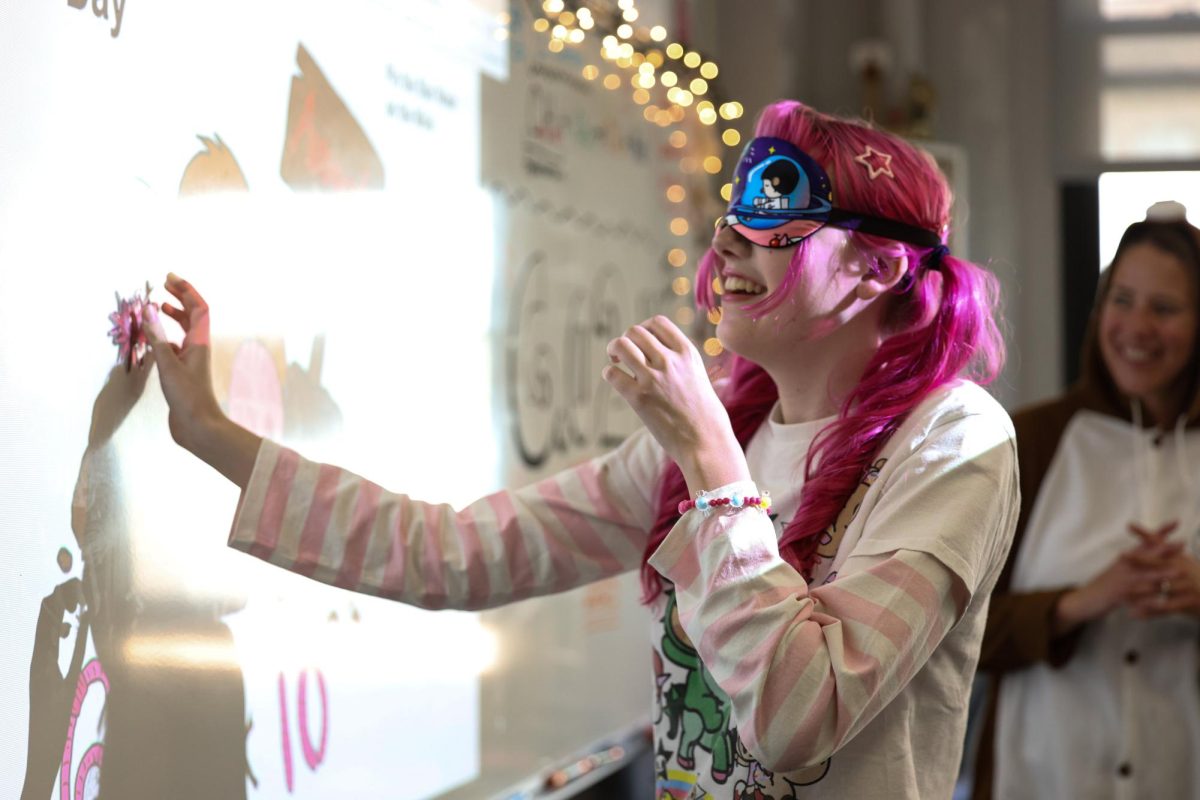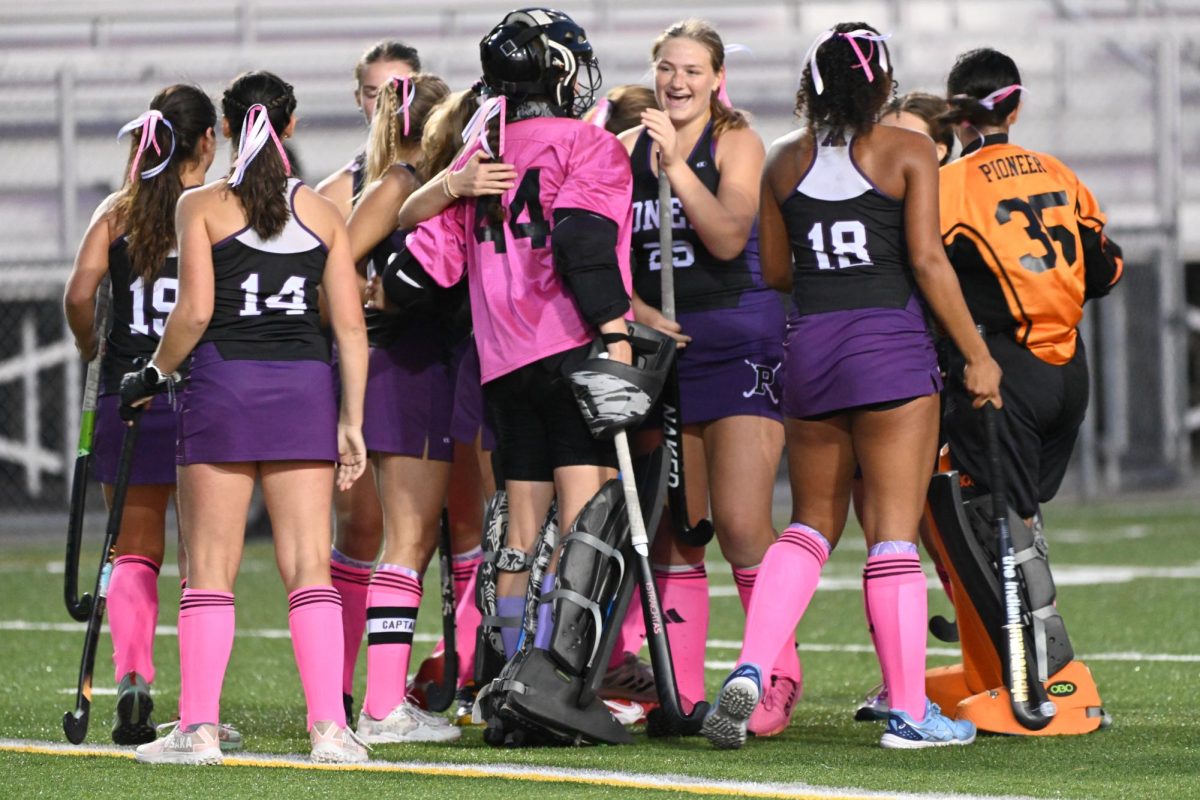
It’s a normal day in Craig Levin’s 7th block Analysis class – a homework check and questions, learning the new material and then working on the next day’s homework. Nothing special in the math world – other than the unveiling of a brand new piece of technology Levin has recently acquired.
“I use an ELMO,” said Levin, commenting on the gadget he received midway through last year’s school year. “For lack of a better word, [it’s] an opaque overhead projector.”
ELMOs are becoming more prevalent in education. ELMOs display images through a camera on a tripod similar to an old-fashioned overhead projector; whatever is front of the teacher is shown to the students. But because the ELMO projects opaque images and not just transparent slides, Levin is able to show his students the text book page he is looking at, the graphing calculator he is using and even themselves; the camera is set up on a tripod and it can be rotated and focused on the students.
Levin rotates the camera and points it towards the students who are immediately displayed on the projection screen. Many smile and wave at themselves and fellow students.
“The big advantage of the ELMO is that we can look directly at student work, handwriting and everything,” said Levin, “which I think in some ways is very superior to a chalkboard which is sometimes clumsy, and sometimes kids are reluctant to go up to the board.”
Despite the benefits the ELMO creates, it is difficult for each faculty member to own one; each ELMO can cost up to $760.
“It would be great,” said Levin, “[if all teachers could have one] because I know Steve Coron would love to have access [so he could] put student art under the projector so they can do critiques.”
Levin hopes to eventually share the school’s sole ELMO with other teachers so they can realize how beneficial it is, and then write a grant proposing that the school be allowed more high tech projectors.
An ELMO isn’t the only piece of technology Levin uses to help his students; he also has his own website and provides graphing calculators to students. Levin designs his website through iWeb, an Apple program, and publishes it using the server space.
Many teachers, including FOS I and Physics teacher Courtney Kiley, use websites to help share information with their students – on these websites, teachers can post the class’ curriculum and assignments.
“[My website] is just on web.mac.com,” said Kiley. “It’s just 100 [dollars] and it’s pretty easy.”
Kiley pays for the website out of her own pocket, but many teachers choose to use the server space the school provides them. This can often lead to messy and poorly conveyed information. One of the benefits to creating your own website is that teachers receive their own domain names, and they are not limited by what the school allows. School websites are generally more basic than the comprehensive websites teachers can create on their own. It is simple to post a link from the school’s website to the teacher’s.
Kiley is also interested in writing a grant in order for the school to have more technology to use in her classroom. Kiley’s Physics class studies acceleration and velocity, and she hopes one day to have cameras that will be able to slow down an object’s motion so students can visually observe changes in velocity and acceleration.
But technology in the schools is not just limited to academic success. Robbie Stapleton, a Personal Fitness and Health teacher at Community, hopes that she will receive more equipment for her to monitor students’ athletic performances.
“In some high schools they have heart monitors hooked up to all their cardio machines,” said Stapleton, “and the teacher can see everybody’s heart rate.”
Stapleton also wishes that all of her students had a GPS, a device commonly used to measure distance when running based off of satellites. Stapleton believes it would be more efficient to tell students to go run four miles instead of having to lead the whole group in a four mile run; the latter is difficult because students run at different paces and Stapleton needs to show all the students the route.
Stapleton actually digressed technologically in her health class; she noticed that students get tired of technology very quickly. Whenever she told her class they were going to be using PowerPoint, she heard a collective groan. Stapleton now uses overhead projections because she is able to take notes while giving the lecture, making it more stimulating for her students.
Stapleton states that there are other things she desires before new technology, such as a bigger room, suspended wood floor, mats under the weight machines and better technology in terms of weight training, such as weight machines. Students notice that much of Stapleton’s weight room equipment is outdated and worn down.
Stapleton notes that all of the technology used in today’s schools might make education a little bit too easy for students – while students should learn independence when they’re in high school, PowerSchool and online websites don’t help. A lack of technology may promote students to come to class more because that would be their only chance to obtain the information that they need. On many websites, teachers will post the entire PowerPoint that they presented earlier in the day. Therefore, students can miss class but still gather the information they need to pass the next test.
Stapleton is also concerned that it is sometimes a challenge for students to find the information that they need online because of the multiple websites. She states that if everything were under one website, it would be much easier for students. The district has not had time to put something like this together.
Added technology has made it easier for students to check grades, but it has made it more difficult for teachers to keep track. Simple things such as attendance have changed from one step to three step processes over the years. Teachers now need to submit the attendance not only to the school but also to PowerSchool.
It has also made papers and assignments easier for students. Stapleton says that her sons in college have more distractions, such as social networking sites and cell phones, but they are able to finish their papers faster. Instead of going to a library, students can now find all of the information that they need on their laptops.
Community students have found the advanced technology beneficial. Many students note that their teachers use PowerPoint for presentations, and that websites are helpful when students forget assignments. Of course, if teachers don’t update their websites constantly, it makes it difficult for students to find assignments outside of school.
“I think they can be really useful,” said senior Christine Hagan, “but it’s going to depend on how well the teacher can maintain the website because if the teacher is not actually keeping up with the website it is going to be very difficult.”
“Sometimes [the websites] are a little unneeded but they can be helpful,” said senior Ben Gleichert. “They’re another resource you have available to you all the time.”
Gleichert notes that although the websites are not professionally created, they do a good job displaying the information the students are searching for. He does note that it is sometimes difficult to find the sites because of the URLs.
Of course, students aren’t only using the technology the school provides to them, but they are using personal technology as well. Cell phones and iPods are constantly seen in the hallways and classrooms in local high schools. While some teachers are more lenient about cell phone policies, many teachers feel that they should not ever be seen in class.
“[Technology] has a place in school and it doesn’t have a place in school,” said Kiley. “I don’t think kids should be texting in class, I don’t think kids should always have earphones in.”
While Kiley believes that iPods and cell phones should be forbidden from the classroom unless under emergency situations, other teachers, such as Craig Levin, have found ways to incorporate students learning and personal technology.
Last year, Levin discovered a website known as Wolfram Alpha, a search engine that has the mixed characteristics of a graphing calculator and Google. Wolfram Alpha allows students to plug in math equations and see other ways of looking at it. Levin allowed students to download the program for their iPods and use it in class and even on the math tests.
“[Utilizing personal technology] is something I’ve been working on for years,” said Levin. “I know there are teachers who use texting voting during class, but I see that’s a way to embrace the fact that I recognize that everyone’s texting so let’s put it to our advantage.”
Levin hopes that teachers can continue to incorporate personal technology with school technology because he sees this as an opportunity for students to learn more, but he does worry that students are using their brains less and relying on the tools they are given too much.
“The goal of every teacher is to teach the students to think in different ways,” said Levin, “and we don’t want students to be bogged down by, ‘What is 36 divided by 4?’ but if understanding why 36 divided by 4 is 9 is important to what you’re doing, there has to be a way to bridge how and why things work with the what.”
Levin realizes that teaching facts is “totally moot” now because it is so simple for students to access information by using the Internet.
“You could ask two-thirds of the kids in this building to find a factual piece of information,” said Levin, “and they’d have the answer in less than five seconds.”
Levin hopes teachers will be able to realize this and that students will continue to learn.








